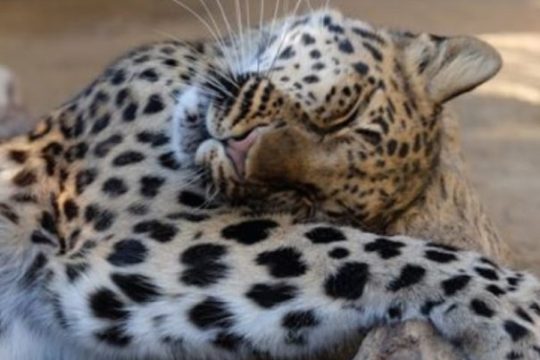#Exotic Feline Breeding Compound
Link
“Hemker Zoo and Park in Freeport has taken in an Amur Leopard and three Pallas Cats. Zoo owner and director Joan Hemker told KNSI News that having the animals helps further their goal. “By bringing these endangered species to the zoo, it will help us with our mission of teaching all generations about the importance of caring about animals that are endangered and need help.”
She says only around 100 Amur Leopards are left in the wild and around 180 in captivity. Both species are cold-weather cats native to Russia and China, making them a good fit for Minnesota’s climate. Hemker says the leopard is a large cat breed, and the others look distinct. “The Pallas Cats are smaller. We always say they resemble house cats, but they tend to look like a grumpy old man. And we think kids will really enjoy them a lot.”
The rare cats come from the Exotic Feline Breeding Compound (EFBC), a nonprofit in California that was forced to close its doors in February due to financial hardship.”

#Hemker Zoo#Hemker Park and Zoo#Exotic Feline Breeding Compound#Amur leopard#Far Eastern leopard#Pallas's cat#Manul#big cat#endangered#article#captive#photo
22 notes
·
View notes
Photo










Wanna take a break from the bustling streets of the city and just sit back and relax on your hammock, breathing in fresh, cool air? Then, we’ve got the perfect place for you. This 10-acre-wide rough diamond in the far-off hillsides of Mojave, California rests along 90th St. W and is surrounded by the vast plains of Kern County. It enjoys the warmth of the soft Californian sun during the day and draped by starry skies at night.
Mojave is a community in Kern County, California, United States and is located 50 miles east of Bakersfield, and 100 miles north of Los Angeles. Although located a bit on the far side of the city, your new property is not all that distant from what the city has to offer such as, its diverse cuisine selection and outdoor recreational areas.
Explore the Mojave National Preserve
For only a 2-hour drive down East of your new property is the Mojave National Preserve – the third largest site ran by the National Park Service in the United States. Its vast wilderness offers a variety of outdoor activities such as camping and hiking all the while learning more about its rich history. Northeast of the park is the historic cross that serves as a memorial to war veterans. While, at the middle, is the Kelso Depot – a beautiful railroad depot and was once a prominent railroad stop not turned into a museum.
Great Outdoor Recreational Areas
33 minutes up North from your property is the Tomo-Kahni State Historic Park where you can get to learn about the Kawaiisu people and their form of living. Also, some of the plants that are native to the place are presented during the tour.
You can also get up close and personal with some of the world’s big cats in the Exotic Felines Breeding Compound located on Rosamond Dr. just 21 minutes away from your property.
While you’re there, take on a side trip at the Willow Springs International Raceway and the Rosamond Summit.
What are you waiting for? Call us now and know more about the offer!
THIS IS YOUR OPPORTUNITY TO OWN A PRIME BUILDING LOT FOR ONLY $15,000!!
Not ready for a cash purchase? NO PROBLEM!
We offer Seller Financing!! – No Credit Checks, Flexible Payment Terms
Pricing Details:
Cash Price: $15,000
Financing Price : $18,999
Down Payment : $5,999
Monthly Payment: flexible
Property Details:
County: Kern
State: CA
Parcel Number: 237-053-11-00
Size (in acres): 10 Acres
City: Mojave
Zip Code: 93501
Center GPS Coordinates: 35.0045, -118.2999
GPS Coordinates of Lot Corners:
35.00544, -118.30106
35.00365, -118.30106
35.00365, -118.29885
35.00546, -118.29883
Elevation: 3251.3 ft
Road Access: Landlocked
Terrain: Hillside
Electricity: Cannot determined what company services in the area
Sewer: Would need to install septic
Water: Would need to dig a well
Zoning: A-1 (LIMITED AGRICULTURE)
Annual Taxes: $261.84
HOA: County doesn't have information on this, they suggest confirming this to the owner
What type of construction:
Buy this property today for just $15, 000!
Interested? Call or Text Neel @ 928-286-7286 or email [email protected].
You can also visit our website at www.toplandsales.com for more details.
1 note
·
View note
Photo

Went out scouting and found some sweet locations! 🌟 Search between an old Mine shaft, Cave and a Prairie. To find an exotic feline zoo! #feline (at Exotic Feline Breeding Compound) https://www.instagram.com/p/BnNNzmkgG2c/?utm_source=ig_tumblr_share&igshid=72slexxi0lf6
3 notes
·
View notes
Photo

We visited the big cats today at the EFBC in Rosamond! 🤗 (at Exotic Feline Breeding Compound) https://www.instagram.com/p/CY2rCAXLyLo/?utm_medium=tumblr
0 notes
Text
20 Questions with Dr Ferox #23
Whelp, time for another blast of 20 questions and comments from the inbox. If you were brave enough to use your username I’ve tried to tag you (Thanks Tumblr) but if you were on anon, you’ll have to look yourself.
Would you folks be interested in me answering these sort of short questions in a video instead? Let me know in the replies. Now here we go!
Anonymous said: do u play mobile games on your phone, like animal crossing pocket camp? :O
No, should I? I haven't heard much about it.
@trisaratops45 said: Dr. Ferox, First off I just started following your blog and love it! I'm stuck using mobile so I can't see your faq information. I was just wondering if the clinic you work at sees any exotic or pocket pets? Of so what is your favorite to see and treat? Thank you!
Welcome! We don't see a huge amount of exotics at my clinic, we're not well set up for them, but ferrets are probably my favorites.
Anonymous said: do you follow any medblr blogs? and if you do, are you ever like 'thank goodness i don't have to deal with that' or 'man i wish it was that easy'? question tax: what is your favorite depiction of dragons from fantasy media
I actually had to go check which blogs I was following. No active medblr blogs in the list anyway. I often see real clients, in the flesh, and think 'Im glad i don't have to deal with that', especially when they describe to me their own gross medical problems as though I want to know exactly what's coming out of their orifices.
All dragons are good dragons. I don't think i could pick a favorite.
@the-noble-banana said: What style of nail clippers are best for trimming a cat's claws?
Whatever you're comfortable with. I like these ones
Anonymous said: Do dogs get acne? Is that a thing? Just curious! Question tax: if you could shoot something out of your finger, what would it be?
They can get comedones with certain hormonal conditions (black heads) and can get pimple-like lesions with skin infections.
I would shoot icy cold water out of my fingers. Great for hot days, and for stupid faces.
Anonymous said: Do you typically bandage and cover amputations? At the vet I worked at (I was only kennel so everything I saw was in passing) every animal who had limb amputation left after a day or two with the incision fully bandaged. My dog had her hind leg amputated and the vet (different one) had her in and out in under three hours and sent her home unbandage. Just out of curiosity is it case by case that you decide to bandage? Gave my mom a little heart attack seeing her all bloody and swollen
We might but a light dressing over them, but in an amputation of anything more than a toe there's often not much to bandage. Limb amputations are typically very high up the limb in dogs and cats and it's hard to bandage something in that position. Also, sometimes dogs eat the dressing.
@crimsonrose95 said: I'm not vet med, but I am into chemistry and physical sciences and the ask talking about chemistry being inconsistent is so weird a thought to me. Biology is way less consistent than chemistry like chemistry is mostly math with elements and compounds while biology is mostly names. It's just really interesting how most people start to think a science they don't like and have trouble in is just the science being completely inconsistent to them. Me included.
I get what you mean. Chemistry has a fairly distinct set of rules, even if they're rules you've not encountered outide of chemistry before. I was never a fan of physics, but it is consistent. Biology likes to bend rules. Life finds a way.
Anonymous said: Why does my cat yell when I try to use the bathroom alone? Question tax: what's your favorite thing about Australia?
Possibly he thinks you need moral support? Or that there's demons in there.
My favorite thing about Australia is our universal healthcare system and gun control.
@foxtrottarts said: How common is dewclaw removal in dogs, and what are the benefits/downsides?
Hind dewclaw removal is relatively common at the time of deseing, if they're the sort that flop all over the place and lack a boney attachment. Front dewclaws are usually left, unless removed for a medical reason. I've written about it before here. https://drferox.tumblr.com/search/dewclaw
Anonymous said: Can a dog still have the MDR1 gene if they have never reacted to those drugs in the past (lets says a dog that has regular flea prevention of selemectin)
If the dog has only had a popular flea product containing selamectin but has never had ivermectin, yes they could still have it. MDR1 dogs typically don't react to that product, nor do they react to the annual heartworm injection.
Anonymous said: Hello, I had a question as google only takes me but so far, and the results were iffy at best since it's difficult to locate a vet or someone in a position who would know the answer. How much of a danger is animal or human saliva to pet birds? Some people say kissing the bird, or having another pet such as a dog lick/groom them is an issue, but I'm just lost on if any is true, and would love to find the answer. Thanks a ton in advance since it's all pretty confusing.
It is a potential issue. Carnivore saliva contains many bacterial species that can be devastating to birds or other mammals even through relatively small abrasions. Carnivores should not be permitted to interact with prey species and birds. Cats are especially risky because they're so pointy and because they effectively coat themselves in saliva when grooming. You can find some more information here.
Anonymous said: Hi Dr. Ferox, we recently had to put our cat down due to health issues. We're pretty sure he had FIP as the last week of his life he had every symptom but one. A website we saw said the virus can live in the environment for weeks afterwards and I was wondering if you knew any sort of approximate time. We aren't ready for another cat yet but occasionally foster a kitten and don't want to bring one into the house and have it get sick
I typically reccomnd 4 months, and replacing bedding, litter trays and food dishes. While you are probably fine with 3 months, given the incurable and devestating nature of FIP (Feline Infection Peritonitis) I prefer to err on the side of caution.
@kumoi-no-hikari said: I got a couple rats a few months ago and the lady I bought them from mentioned that most vets don't know much about rats and will probably do more harm than good unless the situation is extreme. Is that true? They haven't had any issues, but I'm worried about traumatizing them or wasting money if they ever have a problem.
Some vets will certainly be better equiped or more interested in treating rats than others, but you'll only know if you call around and ask them. If they're not keen on seeing rats, they might know somebody who is. I think saying 'most vets don't know X' is unfair when you look at the diversity of vets in the world. Call around, plan for the worst ahead of time.
Anonymous said: Do you know how taxidermy works? I plan this route for my cat when she's passes, do I have to contact them before the body stiffens or position her first?
No idea. But I would contact them well in advance incase they have waiting lists or something. But I would think very carefully about whether taxidermy of a pet is something you definitely want.
Anonymous said: Hey there! What’s your favorite brand of stethoscope?
The Littman is what I use and have been very happy with my Classic II.
Anonymous said:Our poodle mix loved grabbing a mouthful of food then running to the living room to eat it - not necessarily to be near us, he just would eat over carpet. Sometimes we'd rearrange the living room so it wasn't a direct shot from the dining room and he'd still run around the furniture to eat there. He also once pooped one piece on each stair when we were gone all day for some unfathomable reason.
There is so much that could be going on there, but since you didn't seem to ask a question I'm not sure what you'd like me to say.
Anonymous said: On the topic if dog eating things they shouldn't. A shitzu swallowed the end of a large chew bone whole and when she puked It up it was about the size of my fist.
Little dogs often seem to overestimate what they can safely eat. Westies seem to be the worst for this though, and are a common breed to see for stuff getting stuck in their oesophagus.
Anonymous said: About people thinking vets are scammers, my family was so bad with this when I was a child. I remember I had a sick kitten, I was around 8, it had some lung issues and I begged and cried to vet it and my dad said "pray really really really hard to God every hour, and maybe he'll bring a miracle!" and the cat died the next day :( I get so LIVID when people refuse taking their pets to vets for stuff that cannot wait. Makes me wanna slap those people senseless!
Your Dad sounds like a lazy asshole and a cheapskate. Even if god existed, I'm pretty sure he wouldn't appreciate being dialed up for a miracle like a pizza delivery.
Anonymous said: i just wanted to tell you that i recently adopted an older orange tabby cat (dsh) and he is large. like not just fat (which we are working on), but unusually tall and long. like. maine coon size. he has so far used his size to swipe bacon off a kitchen counter and remain an effective roadblock. he's very calm and sweet, i love my big fat baby.
Congratulations on your new addition! I'm sure your big orange boy loves you back too.
@mise-en--place said: Thought you might appreciate this. We got records on a cat today and on a previous visit they stated; "BCS 5/9. Cat appears to be about 7lbs through the gloves and towel." We got a good laugh, cat was actually quite calm for her visit.
I received a history for my old cat Dippa who had once very badly bitten this other vet that only said "Appears healthy in cage. Vaccinated in cage. Dr Ferox is welcome to come and perform a dental on her own cat any time she likes."
I took that to mean "I'm not touching this hellbeast. You deal with her."
57 notes
·
View notes
Video
youtube
I paid a visit to EFBC (exotic feline breeding compound) a feline sanctuary in California! I got the behind the scenes tour from my buddy Missy and got to see all of the gorgeous kitties pretty close! Pretty please consider subscribing to my youtube and maybe giving a like or two and leaving some pleasant commentary! I got to see tigers, leopards, sand cats and more!
2 notes
·
View notes
Photo

Here's the sketch that I started at the exotic feline breeding compound in rosamond and finished in a quick live video. This is an Amur Leopard one of the rarest big cats in the world. #amurleopard #leopard #leopardsketch #penandink (at Exotic Feline Breeding Compound)
2 notes
·
View notes
Photo

Amazing #adventures #showingoff for the #ladies at the #exoticcat #breedingcompound 🕊🐯 (at Exotic Feline Breeding Compound)
0 notes
Text
Is A Dog Grooming Company Correct For You?
There are many exotic vacation locations on the earth. On the other hand, there are really number of exotic but cheap holiday break hotspots. In circumstance sunshine, sand, and surf is your plan of a very long haul vacation, but the entailing exorbitant costs dampen the mood, then financial institution upon India to prepare your very long awaited desire getaway. There are rather a several seashores distribute across the country, but Goa and Kerala steal the exhibit, when it arrives to some sea facet exciting and frolic. In truth, several website visitors have even drawn parallels involving Goa and Miami. Below is a sampling of some of the most common beaches in Goa.
Maybe an not happy staff just requirements a slight modify in environment or a transform of a activity within their occupation. I know a lady who functions in a pet boarding facility. She is certainly fantastic with individuals and their pets and enjoys all animals. She is very good at what she does and enjoys everything possessing to do with Dogs. But the just one point she hates is getting to clean out cat litter packing containers. I experienced to snicker when I read that, but it's accurate. For some purpose she hates it. So that aspect of her working day that consists of cleaning the litter boxes is enough to place her in a negative mood. But there are other staff there who don't head cleansing litter bins at all. So what I would do is pull her out of the cat space and just maintain her doing work with the pet dogs and the community, which would hold her really content.
Feline scabies is a really contagious affliction. The mite can quickly be transmitted to your cat if he comes into immediate contact with an contaminated animal. If you hold your cat indoors, the probabilities of him coming into make contact with with a stray is nominal. That's why out of doors Cats are typically impacted. Any breed or age can turn out to be contaminated with the mite that brings about scabies in Cats. If mothers are infected, then there is a quite substantial probability that her whole litter will be affected also.
The pasture area itself is surrounded by a protected perimeter woven wire area fence but the broilers are protected by a one strand of photo voltaic driven electric fencing and two guard Animals, a Great Pyrenees pet dog and a llama wether. These Animals are applied to discourage predators as the skid homes are not closed at night time. Given that the introduction of the guard . Animals predator problems have been minuscule. The one wire of electric fence retains the horses and cattle that reside in the identical field out of the skids and chicken feed. Levels and pullets assortment even further than broiler chickens so their compound is surrounded by electric poultry netting to keep them nearer to household.
Back doors, these as patio doors, can be sliding glass doors or French doorways. The former can be made from vinyl or aluminum. If you're cutting on expenses, aluminum is much more desired. It's also uncomplicated to put in. Vinyl is substantially like fibreglass since it is strength successful and doesn't demand a lot of upkeep.
0 notes
Text
Bengal Cat, Leopard in Your Lap
Bengal Cat, Leopard in Your Lap
Ernest Hemingway – a celebrated patron of domestic cats with Bengal Cat, though a frequent despoiler of other species – was asked one evening in a cafe in Malaga, Spain, why, in light of his devotion to hunting, he was always photographed with cats instead of dogs. “Don’t you realize,” said Hemingway, “that the fireside tabby is merely a shrunken lion without a mane?”
Courtesy of Quarto Bengal Cat
Hemingway’s imagination, perhaps, enabled him to read between the stripes and to see the lion that paces the cage within every house cat, but other cat fanciers have earnestly wished that domestic cats could look more like their wild counterparts, thereby taking the imagination out of being close. This desire to get next to the beauty – if not the beastliness – of an exotic species is the chief reason for the creation of spotted domestic breeds, clever knockoffs in fur that are spot-on re-creations of their free-roaming type sakes.
Cat spotting with Bengal cat
Currently, there are four handmade spotted domestic cats: the Bengal cat, the California spangle cat, the ocicat and the Savannah. (A fifth spotted breed, the Egyptian Mau, is naturally occurring.) Three of those breeds – the Mau, the ocicat and the Bengal cat – have been accepted for championship competition by various cat associations. Of those three accepted breeds, the Bengal cat is the only one whose relationship with its wild counterparts is more than skin deep. Developed by Jean Mill of Covina, California, the Bengal cat includes a dash of Asian leopard cat blood among its ingredients.
Mill, now 72, left Des Moines, Iowa, more than 50 years ago to attend Pomona College in California. She earned a degree in psychology and then took several graduate classes in genetics at UC Davis. By 1948 she was one of three breeders in the United States and Canada who were working, unbeknownst to one another, to develop the Himalayan cat, a longhair breed that combines the confirmation of the Persian with the coloration of the Siamese.
Mill, whose surname was Sugden at the time, bought an Asian leopard cat or Bengal Cat (Felis bengalensis) in 1963 when they could still be acquired at some pet shops. She was living with her first husband then on a cattle ranch in Yuma, Arizona. She soon realized that the leopard cat was out of sorts for being out of its natural habitat, which extends from India eastward into China and down through the Malaysian Peninsula.
“She was lonely,” Mill told one reporter, “so I put a black tomcat in there so she would have a little company.”
The leopard cat got over her loneliness long enough to produce a litter of kittens. Mill kept a spotted female from that union and eventually bred that female back to its father, which breeding produced spotted and solid-color cats. Mill’s husband died in 1965, however, and she had to leave the ranch. She gave the leopard cat to a zoo and moved to an apartment in Pomona, California.
Second Time Around Bengal Cat
In 1975, Mill re-married. Her engineer husband, Bob Mill, owned a one-acre horse property in the Covina Hills. Eventually, Jean was once again seeing spotted cats before her eyes. The bulk of her foundation stock – eight females out of crosses between leopard cats and domestic shorthairs (all males from such first-generation crosses are sterile) – was provided by Dr. Willard Centerwall, a pediatrician and geneticist at the University of California at Davis. Centerwall had been studying the leopard cats’ natural resistance to feline leukemia. Leopard cats, one breeder explained, “lack a feline-leukemia genome in their DNA structure, which makes them less susceptible to feline leukemia than domestic cats are.”
Having suddenly become the headmistress of a feline boarding school, Jean Mill set about finding a suitable escort for her charges. She “haunted all 32 shelters” in the Greater Los Angeles area for a year in search of a sturdy, sweet-tempered, domestic shorthair male, preferably a brown-spotted tabby with no white in his coat. (Given the number of females in her care, sturdy was the operative word in this description.)
On a visit to a zoo in Delhi, India, in 1980, Mill spotted a feral, orange domestic cat with deep brown rosettes that lived in the rhinoceros compound and earned its keep as a ratter. Mesmerized by the cat’s beauty – and mindful that any young male that hung out with rhinos wouldn’t be intimidated by eight calling females – Mill later wrote to an official at the zoo who agreed to ship the cat to the United States. There it was assisted in its new employment by a brown-spotted-tabby, domestic shorthair male that Mill had subsequently found in a shelter in Los Angeles.
Into the Fold
In 1983, just eight years after Jean Mill had begun working with Bengals again, the breed was accepted for registration by The International Cat Association (TICA), and eight years after that TICA became the first cat registry in North America to grant the Bengal cat championship status. That recognition was made after TICA’s genetics committee was satisfied that the Bengal cat is indistinguishable on a cellular level from domestic cats and that it exhibits a normal sterility profile. TICA further requires that all Bengals in the show ring be the products of at least three generations of Bengal-to-Bengal breedings. (The Bengal has also earned championship status in the United Feline Organization, the American Cat Fanciers Association, and the Canadian Cat Association.)
Wherever Bengals are exhibited they draw reverent oooohs and aaaaahs and, invariably, two critical questions. The first concerns temperament. Inquiring minds want to know if a genetic recipe containing as much as one-eighth wild blood isn’t a recipe for disaster. The answer is no. Just as one-eighth of a teaspoonful of cayenne pepper adds sprightliness to a dish without inflicting third-degree burns on the tongue, the Asian leopard cat’s influence on the Bengal’s personality is invigorating, but in no way a threatening, presence. Or, as one writer has observed, although Bengals “look a little bit like something you should approach with a whip and a chair. They act like they just oozed out of a … self-help workshop, all sweetness, and cuddles.”
youtube
The second question – regarding differences between Bengals and the two spotted breeds already in championship classes, the mau, and the ocicat – elicits a more complex answer. To begin, the spots on the three breeds are distributed differently: The mau’s in a random fashion; the ocicat’s in a pattern that subtly suggests the classic tabby configuration, and the Bengal’s in a horizontal alignment. There are equally distinguishing color and conformational differences, too, which space and a disinclination to leave the Gentle Reader going around in circles preclude an explication of here.
The Building Code of Bengal Cat
The Bengal cat is a medium to large, sleek, muscular cat – males weigh 10 to 18 pounds, while females are slightly smaller – whose hind-quarters are somewhat higher than its shoulders. The Bengal cat has a broad, modified-wedge-shaped head with rounded contours. Longer than it is wide and a trifle small in proportion to the cat’s body, the Bengal’s head is accented by a large, wide nose with a slight concave curve, high cheekbones, and prominent whisker pads. The Bengal’s ears are medium-small, short, with a wide base and rounded tips. The cat’s eyes are large and oval in shape, though a slight almond shape is also allowed.
A long, thick, muscular neck joins the Bengal’s head to its long, substantial body, which is characterized by heavy bone and considerable muscle. The Bengal’s coat, which is short to medium in length, thick luxurious, and unusually soft to the touch, may display a variety of colors and patterns.
The spotted pattern is distinguished by spots that are randomly or horizontally aligned. Rosettes are preferred to single spotting but not mandatory.
The marbled pattern, though derived from the classic tabby gene, should betray as little of that pattern as possible. Instead, the marble pattern should be as random as real marble, ideally with a horizontal flow when the cat is stretched out. A vertically striped mackerel influence is not desirable.
(adsbygoogle = window.adsbygoogle || []).push({});
Follow us on : Facebook, Twitter, Instagram
The post Bengal Cat, Leopard in Your Lap appeared first on Funny Cute Cats.
from WordPress http://bit.ly/2StIww3
via IFTTT
0 notes
Photo

Obi
30 notes
·
View notes
Text
Desert

(2009)
So you’re coming east on the 14 via Tehachapi and you want some sites? OK. You wanna see a beat up town try Mojave…. Tweeker heaven. Then down the 395 a tad in Rosamond you meet people–well, we met people–who own their own MIGs for fun and are building rocket ships and planning missions to Mars. It also has the Exotic Feline Breeding Compound, which is basically a zoo full of wild cats…
View On WordPress
#Antelope Valley#Antelope Valley Indian Museum#Exotic Feline Breeding Compound#Llano#Mojave Desert#Red Rock Canyon
0 notes
Text
Bengal Cat, Leopard in Your Lap

Bengal Cat, Leopard in Your Lap
Ernest Hemingway – a celebrated patron of domestic cats with Bengal Cat, though a frequent despoiler of other species – was asked one evening in a cafe in Malaga, Spain, why, in light of his devotion to hunting, he was always photographed with cats instead of dogs. "Don't you realize," said Hemingway, "that the fireside tabby is merely a shrunken lion without a mane?"
Courtesy of Quarto Bengal Cat
Hemingway's imagination, perhaps, enabled him to read between the stripes and to see the lion that paces the cage within every house cat, but other cat fanciers have earnestly wished that domestic cats could look more like their wild counterparts, thereby taking the imagination out of being close. This desire to get next to the beauty – if not the beastliness – of an exotic species is the chief reason for the creation of spotted domestic breeds, clever knockoffs in fur that are spot-on re-creations of their free-roaming type sakes.
Cat spotting with Bengal cat
Currently, there are four handmade spotted domestic cats: the Bengal cat, the California spangle cat, the ocicat and the Savannah. (A fifth spotted breed, the Egyptian Mau, is naturally occurring.) Three of those breeds – the Mau, the ocicat and the Bengal cat – have been accepted for championship competition by various cat associations. Of those three accepted breeds, the Bengal cat is the only one whose relationship with its wild counterparts is more than skin deep. Developed by Jean Mill of Covina, California, the Bengal cat includes a dash of Asian leopard cat blood among its ingredients.
Mill, now 72, left Des Moines, Iowa, more than 50 years ago to attend Pomona College in California. She earned a degree in psychology and then took several graduate classes in genetics at UC Davis. By 1948 she was one of three breeders in the United States and Canada who were working, unbeknownst to one another, to develop the Himalayan cat, a longhair breed that combines the confirmation of the Persian with the coloration of the Siamese.
Mill, whose surname was Sugden at the time, bought an Asian leopard cat or Bengal Cat (Felis bengalensis) in 1963 when they could still be acquired at some pet shops. She was living with her first husband then on a cattle ranch in Yuma, Arizona. She soon realized that the leopard cat was out of sorts for being out of its natural habitat, which extends from India eastward into China and down through the Malaysian Peninsula.
"She was lonely," Mill told one reporter, "so I put a black tomcat in there so she would have a little company."
The leopard cat got over her loneliness long enough to produce a litter of kittens. Mill kept a spotted female from that union and eventually bred that female back to its father, which breeding produced spotted and solid-color cats. Mill's husband died in 1965, however, and she had to leave the ranch. She gave the leopard cat to a zoo and moved to an apartment in Pomona, California.
Second Time Around Bengal Cat
In 1975, Mill re-married. Her engineer husband, Bob Mill, owned a one-acre horse property in the Covina Hills. Eventually, Jean was once again seeing spotted cats before her eyes. The bulk of her foundation stock – eight females out of crosses between leopard cats and domestic shorthairs (all males from such first-generation crosses are sterile) – was provided by Dr. Willard Centerwall, a pediatrician and geneticist at the University of California at Davis. Centerwall had been studying the leopard cats' natural resistance to feline leukemia. Leopard cats, one breeder explained, "lack a feline-leukemia genome in their DNA structure, which makes them less susceptible to feline leukemia than domestic cats are."
Having suddenly become the headmistress of a feline boarding school, Jean Mill set about finding a suitable escort for her charges. She "haunted all 32 shelters" in the Greater Los Angeles area for a year in search of a sturdy, sweet-tempered, domestic shorthair male, preferably a brown-spotted tabby with no white in his coat. (Given the number of females in her care, sturdy was the operative word in this description.)
On a visit to a zoo in Delhi, India, in 1980, Mill spotted a feral, orange domestic cat with deep brown rosettes that lived in the rhinoceros compound and earned its keep as a ratter. Mesmerized by the cat's beauty – and mindful that any young male that hung out with rhinos wouldn't be intimidated by eight calling females – Mill later wrote to an official at the zoo who agreed to ship the cat to the United States. There it was assisted in its new employment by a brown-spotted-tabby, domestic shorthair male that Mill had subsequently found in a shelter in Los Angeles.
Into the Fold
In 1983, just eight years after Jean Mill had begun working with Bengals again, the breed was accepted for registration by The International Cat Association (TICA), and eight years after that TICA became the first cat registry in North America to grant the Bengal cat championship status. That recognition was made after TICA's genetics committee was satisfied that the Bengal cat is indistinguishable on a cellular level from domestic cats and that it exhibits a normal sterility profile. TICA further requires that all Bengals in the show ring be the products of at least three generations of Bengal-to-Bengal breedings. (The Bengal has also earned championship status in the United Feline Organization, the American Cat Fanciers Association, and the Canadian Cat Association.)
Wherever Bengals are exhibited they draw reverent oooohs and aaaaahs and, invariably, two critical questions. The first concerns temperament. Inquiring minds want to know if a genetic recipe containing as much as one-eighth wild blood isn't a recipe for disaster. The answer is no. Just as one-eighth of a teaspoonful of cayenne pepper adds sprightliness to a dish without inflicting third-degree burns on the tongue, the Asian leopard cat's influence on the Bengal's personality is invigorating, but in no way a threatening, presence. Or, as one writer has observed, although Bengals "look a little bit like something you should approach with a whip and a chair. They act like they just oozed out of a ... self-help workshop, all sweetness, and cuddles."
https://www.youtube.com/watch?v=XDbYR0ExLw0
The second question – regarding differences between Bengals and the two spotted breeds already in championship classes, the mau, and the ocicat – elicits a more complex answer. To begin, the spots on the three breeds are distributed differently: The mau's in a random fashion; the ocicat's in a pattern that subtly suggests the classic tabby configuration, and the Bengal's in a horizontal alignment. There are equally distinguishing color and conformational differences, too, which space and a disinclination to leave the Gentle Reader going around in circles preclude an explication of here.
The Building Code of Bengal Cat
The Bengal cat is a medium to large, sleek, muscular cat – males weigh 10 to 18 pounds, while females are slightly smaller – whose hind-quarters are somewhat higher than its shoulders. The Bengal cat has a broad, modified-wedge-shaped head with rounded contours. Longer than it is wide and a trifle small in proportion to the cat's body, the Bengal's head is accented by a large, wide nose with a slight concave curve, high cheekbones, and prominent whisker pads. The Bengal's ears are medium-small, short, with a wide base and rounded tips. The cat's eyes are large and oval in shape, though a slight almond shape is also allowed.
A long, thick, muscular neck joins the Bengal's head to its long, substantial body, which is characterized by heavy bone and considerable muscle. The Bengal's coat, which is short to medium in length, thick luxurious, and unusually soft to the touch, may display a variety of colors and patterns.
The spotted pattern is distinguished by spots that are randomly or horizontally aligned. Rosettes are preferred to single spotting but not mandatory.
The marbled pattern, though derived from the classic tabby gene, should betray as little of that pattern as possible. Instead, the marble pattern should be as random as real marble, ideally with a horizontal flow when the cat is stretched out. A vertically striped mackerel influence is not desirable.
(adsbygoogle = window.adsbygoogle || ).push({});
Follow us on : Facebook, Twitter, Instagram
Read the full article
#bengal#Bengal(AnimalBreed)#Bengalcat#bengalcatmeow#bengalcatnoises#bengalcattalking#bengalcats#bengalcatsmeowing#bengalcatstalking#bengalmeow#bengaltalking#Bengalvideos#bengals#cat#catchirping#catmeowing#cats#catschirping#catsmeowing#catsmeowingateachother#catstalking#catstalkingtoeachother#chirpingcat#funnycatvideos#funnycats#hotrocketbengalcats#kittens#meowing#noisycat#noisycats
0 notes
Link
Exotic Feline Breeding Compound Coupons & Discounts | 2017 | Rosamond, California — The Know and Go: USA Vacation Travel Coupons & Discounts https://goo.gl/xIkNBR #Coupons & #Discount #2017 #Rosamond #California #thecathouse #felineConservationcenter
0 notes
Photo

Amur Leopard drawn from life #amurleopard #drawnfromlife #leopardsofinstagram #spotted #penandink (at Exotic Feline Breeding Compound)
0 notes
Photo

Here are some Jaguar sketches from yesterday. One of my favorite follows is @alan_rabinowitz who studies and protects jaguars. #jaguar #blackjaguar #bigcat #penandink #watercolor (at Exotic Feline Breeding Compound)
0 notes